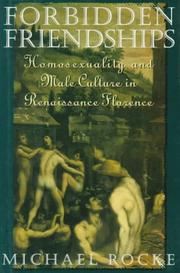Check nearby libraries
Buy this book

The men of Renaissance Florence were so renowned for sodomy that "Florenzer" in German meant "sodomite." Indeed, in the late fifteenth century, as many as one in two Florentine men had come to the attention of the authorities for sodomy by the time they were thirty. In the seventy years from 1432 to 1502, some 17,000 men - in a city of only 40,000 - were investigated for sodomy; 3,000 were convicted and thousands more confessed to gain amnesty.
Michael Rocke vividly depicts this vibrant sexual culture in a world where these same-sex acts were not the deviant transgressions of a small minority, but an integral part of a normal masculine identity.
Rocke uncovers a culture in which sexual roles were strictly defined by age, with boys under eighteen the "passive" participants in sodomy, youths in their twenties and older men the "active" participants, and most men at the age of thirty marrying women, their days of sexual frivolity with boys largely over. Such same sex activities were viewed as a normal phase in the transition to adulthood, and only a few pursued them much further.
Rather than precluding heterosexual experiences, they were considered an extension of youthful and masculine lust and desire. As Niccolo Machiavelli quipped about a handsome man, "When young he lured husbands away from their wives, and now he lures wives away from their husbands." Florentines generally accepted sodomy as a common misdemeanor, to be punished with a fine, rather than as a deadly sin and a transgression against nature.
There is no word, in the otherwise rich Florentine sexual lexicon, for "homosexual," nor is there a distinctive and well-developed homosexual "subculture." Rather, sexual acts between men and boys were an integral feature of the dominant culture.
Rocke roots this sexual activity in the broader context of Renaissance Florence, with its social networks of families, juvenile gangs, neighbors, patronage, guilds, and confraternities, and its busy political life from the early years of the Republic through the period of Lorenzo de' Medici, Savonarola, and the beginning of Medici princely rule.
Check nearby libraries
Buy this book

Previews available in: English
Subjects
Social life and customs, Boys and men, Gay men, Homosexuality, Male, Renaissance, Nonfiction, Male Homosexuality, Sex customs, Homophobia, Sodomy, History, Renaissance, italy, Florence (italy), history, LGBTQ historyPlaces
Florence, Florence (Italy), ItalyTimes
Renaissance, 14th century, 15th century| Edition | Availability |
|---|---|
| 1 |
zzzz
Libraries near you:
WorldCat
|
|
2
Forbidden Friendships: Homosexuality and Male Culture in Renaissance Florence (Studies in the History of Sexuality)
February 9, 1998, Oxford University Press, USA
in English
0195122925 9780195122923
|
zzzz
Libraries near you:
WorldCat
|
|
3
Forbidden Friendships: Homosexuality and Male Culture in Renaissance Florence
1998, Oxford University Press
in English
1280470887 9781280470882
|
zzzz
Libraries near you:
WorldCat
|
|
4
Forbidden Friendships: Homosexuality and Male Culture in Renaissance Florence
1997, Oxford University Press
in English
0195122925 9780195122923
|
cccc
Libraries near you:
WorldCat
|
|
5
Forbidden friendships: homosexuality and male culture in Renaissance Florence
1996, Oxford University Press
in English
0195069757 9780195069754
|
aaaa
Libraries near you:
WorldCat
|
Book Details
Edition Notes
Includes bibliographical references (p. 331-346) and index.
Originally presented as the author's thesis (Ph. D.--State University of New York at Binghamton).
Classifications
The Physical Object
ID Numbers
Source records
Scriblio MARC recordLibrary of Congress MARC record
Library of Congress MARC record
marc_openlibraries_sanfranciscopubliclibrary MARC record
Library of Congress MARC record
Better World Books record
marc_columbia MARC record
Work Description
"This is a superb work of scholarship, impossible to overpraise.... It marks a milestone in the 20-year rise of gay and lesbian studies."--Martin Duberman, The Advocate
The men of Renaissance Florence were so renowned for sodomy that "Florenzer" in German meant "sodomite." In the late fifteenth century, as many as one in two Florentine men had come to the attention of the authorities for sodomy by the time they were thirty. In 1432 The Office of the Night was created specifically to police sodomy in Florence. Indeed, nearly all Florentine males probably had some kind of same-sex experience as a part of their "normal" sexual life. Seventy years of denunciations, interrogations, and sentencings left an extraordinarily detailed record, which author Michael Rocke has used in his vivid depiction of this vibrant sexual culture in a world where these same-sex acts were not the deviant transgressions of a small minority, but an integral part of a normal masculine identity...
Excerpts
Community Reviews (0)
Feedback?History
- Created April 1, 2008
- 11 revisions
Wikipedia citation
×CloseCopy and paste this code into your Wikipedia page. Need help?
| August 3, 2024 | Edited by MARC Bot | import existing book |
| January 17, 2023 | Edited by ImportBot | import existing book |
| November 20, 2020 | Edited by MARC Bot | import existing book |
| May 19, 2019 | Edited by MARC Bot | import existing book |
| April 1, 2008 | Created by an anonymous user | Imported from Scriblio MARC record |















